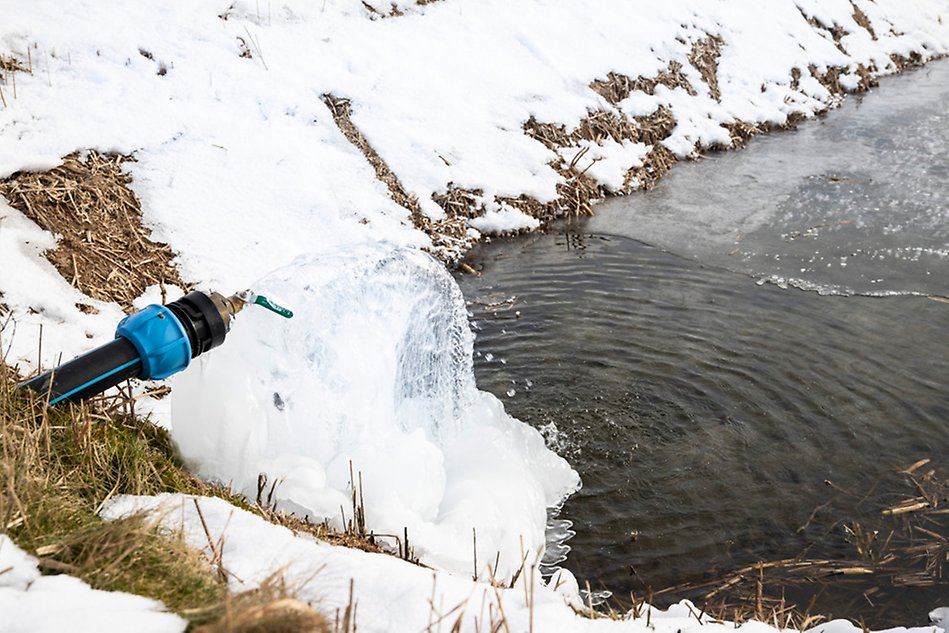Wetlands effective against eutrophication of seas and bodies of water
Eutrophication is a global problem that affects countless lakes, rivers and coastal marine areas. Its harmful consequences, such as toxic algal blooms, are harmful to both animals and humans. Research from Halmstad University and Uppsala University shows that wetlands can be part of the solution, and a way to protect people and nature.
“The aim of the thesis was to increase knowledge about nitrogen removal so that future wetlands can contribute to the protection of our valuable water resources to an even greater extent.”
Josefin Nilsson, Doctor in Limnology
In her thesis, Josefin Nilsson, who recently defended her doctoral thesis in limnology, investigates nitrogen removal in constructed wetlands – an important process for reducing the problems of eutrophication. Nitrogen removal is important to reduce or remove the excess of nitrogen compounds that can be found in aquatic environments, and which leads to eutrophication in lakes, rivers, and seas.

Josefin Nilsson
“For example, the thesis is about what type of vegetation should be planted, where wetlands should be placed and how they should be designed to promote nitrogen removal. In addition, I have investigated interactions between nitrogen removal and other ecosystem services – products and services that nature provides to us humans, and that contribute to our quality of life. I have also investigated how nitrogen removal is affected by changes in climate conditions, as well as when plants are harvested. Another area has been the installation of floating wetlands – floating platforms planted with reeds,” says Josefin Nilsson, and continues:
“The aim of the thesis was to increase knowledge about nitrogen removal so that future wetlands can contribute to the protection of our valuable water resources to an even greater extent.”
What is a wetland?
A wetland is a place where there is water just above or below the surface of the ground during large portions of the year. Wetlands are among the most species-rich environments in Sweden and are therefore important for biodiversity. They also help us with ecosystem services – products and services that nature provides us humans, and that contribute to our quality of life. An example of ecosystem services is how the forest contributes to the regulation of water, carbon sequestration, pollination and nature for experiences and production of food, wood raw materials and bioenergy.
Agriculture contributes to eutrophication
Agriculture is a major contributing factor to eutrophication due to the use of industrially produced fertilisers, which leads to nitrogen leaching into the surrounding environment and being transported from arable land to the sea.
“Constructed wetlands are artificial wetlands in the agricultural landscape and can reduce nitrogen transport by separating nitrogen from water. Wetlands can thus help to reduce eutrophication and protect both people and nature,” says Josefin Nilsson, who also points out that the location and design of wetlands is important:
“Wetlands should be located downstream from fertilised fields, where as much runoff from agricultural land as possible can be captured. An elongated shape of the wetland, with maximum distance between inflow and outflow, leads to a more efficient nitrogen removal.”

High nitrogen removal can be achieved quickly by planting overwater vegetation, such as reeds, in newly created wetlands. Even unplanted wetlands can remove significant amounts of nitrogen after a certain period of time. However, in heavily overgrown wetlands, nitrogen removal may need to be improved, for example through crop harvesting and floating wetlands.
Despite climate change, wetlands seem to retain their function.
“Annual nitrogen removal can continue to be high despite dry summers, provided that the wetlands are correctly placed, designed and receive large amounts of nitrogen-rich water during winters,” says Josefin Nilsson and goes on to explain:
“Even in wetlands that are designed to buffer water flows and reduce flooding, effective nitrogen removal can be achieved, but in order to best promote both nitrogen removal and the delivery of other ecosystem services, entire landscapes with several wetlands are needed.”
About the thesis
Title of the thesis: Nitrogen Removal in Created Wetlands: Considerations – Challenges – Possibilities External link.
External link.
The defense took place at Uppsala University on 19 October 2023.
External reviewer: Professor Jennifer Tank, University of Notre Dame, USA
Supervisor: Professor Antonia Liess, Halmstad University
Early interest in natural sciences
Josefin Nilsson has been interested in natural sciences since childhood, and chemistry and biology were her favourite subjects in primary school. During her bachelor's degree in Environmental Health, she became interested in pollutants in soil and water, and when she came into contact with Halmstad University's professors Antonia Liess and Stefan Weisner, she became interested in wetlands. After a master's degree in Environmental Science from Halmstad University, she was accepted for doctoral studies at Uppsala University, but with a position as a doctoral student at Halmstad University. This meant that Josefin Nilsson was able to continue the work she had already started in her bachelor's and master's theses. As Doctor of Limnology, she wants to explore the field further:
“My plan for the future is to continue researching – there is much more to find out about wetlands!”
Text: Christa Amnell
Picture: Dan Bergmark and private

